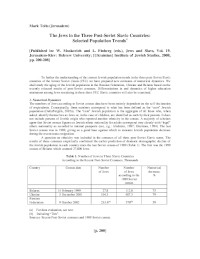The Jews in the Three Post-Soviet Slavic Countries: Selected Population Trends
Author(s)
Publication Name
Publication Date
Publication Place
Publisher
Abstract
The data of the recent post-Soviet censuses show that the sizable educational difference among the three Slavic countries persisted after the dissolution of the Soviet Union. According to the 2002 Russian census, 61.1 percent of the Jews aged 20 and over had attained higher education; for Russian Jews this percentage was higher by 1.2 and 1.5 times than for those in Ukraine and Belarus, respectively. Among younger Jews who remained in the Russian Federation I found a decrease in educational attainments as compared with older cohorts. The highest educational attainments were of Jews who received their degrees mostly in the Soviet period. Sizable differences were also found in the levels of aging and education within the Jewries of these countries.
Topics
Editor
Genre
Geographic Coverage
Copyright Info
Pre-publication draft courtesy of the author
Original Language
Series Title
Series Number
19
Page Number / Article Number
200-208
ISBN/ISSN
9789663780641
Worldcat Record
Link
PDF (via academia.edu), The Jews in the Three Post-Soviet Slavic Countries: Selected Population Trends
Bibliographic Information
The Jews in the Three Post-Soviet Slavic Countries: Selected Population Trends. . 2008: 200-208. https://archive.jpr.org.uk/object-fsu112




